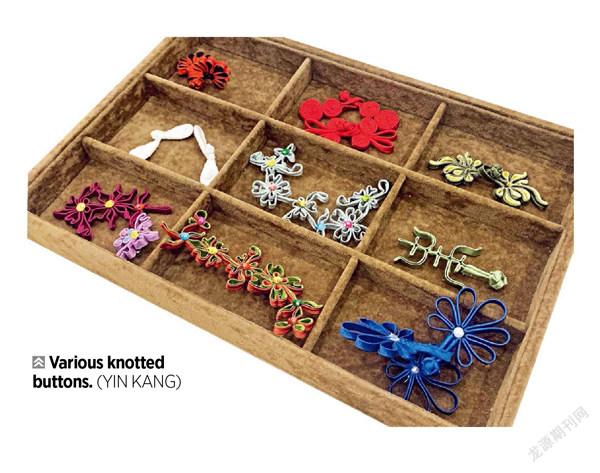In The Mood For Qipao
Yin Kang


Fn a simple and traditional building in Beijing’sDongcheng District, qipao master Li Kan is puttingthe final revisions on several dresses she hascreated for her clientele. In the corner of her studio, a finished product daintily dangles from a rack.“We offer both the classic Beijing-style qipao, orcheongsam, and modified ones, catering to women of all ages,” said Li.
Since the traditional Beijing version first graced magazine covers in the early 1920s, this particularstyle, known for its demure elegance, has gainedworldwide fame. In 2007, it was added to the list of Beijing municipal intangible cultural heritage; Li is a fourth-generation inheritor.
Li doesn’t watch movies often, but she hasfrequently indulged in Wong Kar-wai’s 2000masterpiece In the Moodfor Love. She appreciatesthe female grace this movie delivers through heavy qipao presence.
“This dress is one of China’s most traditionalapparels and an integral part of the nation’s culture,” said Li. “Despite the inflow of global clothing brands and the younger taste for new and modern styles,traditional clothing should never be overlooked. Itrepresents the indelible aspects of Chinese cultureand should not be confined to movies or museums.”
Apprentice to Master
In 1978, 21-year-old Li was assigned to work at what was then Beijing People’s Clothing
Factory (today’s Hong Du Group) as a needleworkapprentice. She still works in the same factory today. Her expertise on the basics of clothes-making andeye for detail made her stand out during a routinetechnique assessment, and she was soon promoted. She left the production workshop in 1992 to become an apprentice of qipao master Yang Huaizhi,formally becoming an artist devoted to the garb.
The dress looks very simple in terms of its cut, but construction techniques are difficult to learn. For instance, there are more than 100 ways just tohand-tie buttons.
According to Li, a custom-made qipao is specificallydesigned for a specific individual based on 36 points measuredfrom top to bottom includingthe collarbones and elbows.After measuring and cutting,the wearer must try on the pieceseveral times to test whether itis too loose or too tight, too longor too short. A handmade qipaorequires at least half a month tocraft.
Because the qipao requiresmore time and energy than an off-the-rack dress, the garment once fell out of public favorfor quite some time. However, thanks to rising incomes and a growing interest in traditional craftsmanship over the past 15 years, Li’s Beijing-style qipaoagain became all the rage,with orders rolling in. In 2009,she won the title of master ofChinese traditional art skillsawarded by the Beijing municipal authorities. She has also createdqipaos for wives of dignitaries,both local and international, aswell as celebrities. “My passionfor the qipao has sustained meall along,” said Li on her pastfour decades. “I truly enjoythe process of meticulouslydesigning and cutting, and, of course, my customers likingtheir finished products.”
Innovating Inheritance
Although she is maintaining a traditional technique, Li is by no means conservative in her quest for innovation and usage of new textiles and techniques. Sheno longer swears by the linearcutting method typically usedfor traditional dress patterns,but absorbs new methodsprevailing in the current fashion field. Cotton prints resulted ina straightforward qipao fit fordaily wear. Those made of silkand brocade are saved for moreformal occasions. A qipao craftedwith dark-colored cashmereor velvet not only highlights a woman’s figure and elegance, but also helps keep her warm.
Li also took her pioneeringknack to the knotted buttonsby introducing flowers intotheir elaborate styles as well asglimpses of traditional Chinesepainting. “Nowadays, we’restarting to see a growing number of young customers,” Li said.“Some choose to wear a qipaofor important occasions like awedding ceremony, so we needto learn more about the younger ideas and demands by bettercommunicating with them.”
Crafting the Next Generation
Li hopes not just to sell tomore young clients, but alsoto see more youngsters inherit qipao-making skills.
“Recent years have seen many masters retire from the craft,” she said. “As this team of traditionalqipao makers shrinks, we, as acountry, run the risk of losingthe technique for good. Sometailors felt the work was tediousand underpaid and turned toother brands to do design ormarketing. Others quit theclothing sector altogether.” Thegood news is that in recent years, the country has done much topromote national craftsmanship, which has brought varioustraditional techniques back intothe limelight.
A growing number of freshfaces have been joining thelineup to resuscitate thesepractices. “It’s great to see them commit to Chinese culturalheritage,” she explained.
Li has been taking onapprentices since 2008. Sheworks out training schedulesbased on their individualcapabilities and market demand. “I have been working on qipaosfor almost my entire career,and it is my mission to passthis technique on to the nextgeneration,” Li proclaimed.

